
Following is the transcript of the US Department of Defence background briefing with senior defence officials from the Pentagon and senior Intelligence officials by telephone on US operations involving Osama bin Laden
MR GEOFF MORRELL (Pentagon Press Secretary): We have -- we're trying to get in on the phone a couple of our colleagues. This will be their placard, senior intelligence officials. So anyway, thank you guys for coming to join us. We don't have much time because one of our briefers here has another event to attend to, in fact, involving the Pakistanis later on this afternoon here at the building.
So without further ado, why don't we go to our two senior Defense officials who will talk to you guys on background for the next half-hour. And let me turn it over to our gentleman here who can speak -- who has a little bit of updated information to provide you all.
SR. DEFENCE OFFICIAL: OK, I'm going to read from a statement.
Today's religious rites were conducted for the deceased on the deck of the USS Carl Vinson, which is located in the North Arabian Sea. Preparations for at-sea burial began at 1:10 a.m. Eastern Standard Time and were completed at 2:00 a.m. Eastern Standard Time.
Traditional procedures for Islamic burial were followed. The deceased's body was washed and then placed in a white sheet. The body was placed in a weighted bag, a military officer read prepared religious remarks, which were translated into Arabic by a native speaker. After the words were complete, the body was placed on a prepared flat board, tipped up, whereupon the deceased body eased into the sea.
MR MORRELL: So that's our update from here.
If we have our telephone connection, I want to turn it over to our senior intelligence official who's joining us and who can provide additional updates on their perspective this morning.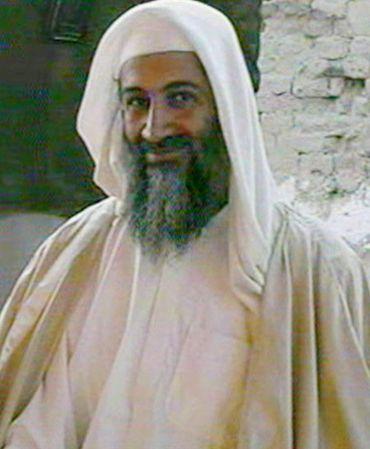
SR INTELLIGENCE OFFICIAL: Good morning. Can you hear us?
MR. MORRELL: Yeah, (briefer name deleted), we can hear you.
SR. INTELLIGENCE OFFICIAL: Fantastic. I'm going to turn it over to my [other senior intelligence official] colleague.
SR. INTELLIGENCE OFFICIAL: Yes, I would just like to give an update on the confidence level and the basis for the confidence level that -- the identification of Osama bin Laden. First, he was visually identified on the scene by those who conducted the raid.
Also on the scene, one of the women on the compound who we assessed to be one of his wives identified him by name as Osama bin Laden. CIA specialists compared photos of the body to known photos of bin Laden last evening, and were able to determine with 95-percent certainty that the body was Osama bin Laden.
And finally, this morning, CIA and other specialists in the intelligence community performed the initial DNA analysis matching a virtually 100-percent DNA match of the body against DNA of several bin Laden family members.
An additional update on materials, quite a bit of materials that were found at the sight and collected: Those materials are currently being exploited and analyzed. And a task force is being set up at CIA to conduct that task, given the volume of materials collected at the raid site.
SR. INTELLIGENCE OFFICIAL: That's the latest update. Where would you like to go from here, Geoff?
MR. MORRELL: Let's start over here, if we could. Why don't we get -- Lita, do you have anything?
Q: Yes. Can you tell us a little bit about whether or not any other people were taken, either, alive out of the compound? Is there is any -- anyone being held, any detainees or anything?
And then just overall, can you give us your assessment of what this means in terms of Al Qaeda and other terrorist organizations, particularly the affiliates who have been operating much more independently from Al Qaeda core lately?
SR. DEFENCE OFFICIAL: Pardon me. No detainees were taken. And this was a significant blow to Al Qaeda, but as the president said last night, the job of disrupting, dismantling and defeating the Al-Qaeda network continues. And I would defer to my Defense colleague and my [senior Intelligence official] colleague for additional information.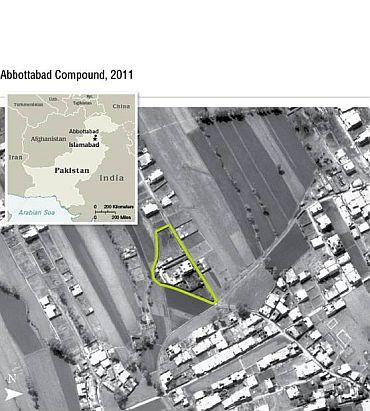
SR DEFENCE OFFICIAL: I would just underscore what the president said again, which is that this sends a -- should send a signal to every member of Al-Qaeda and every affiliate of not only US resolve but US capability to bring those who have killed Americans, killed other innocents, to -- our ability to bring them to justice.
MR MORRELL: David.
Q: Last night could be described as -- well, let me put it this way. It has been reported that this was a kill operation, that there was no intention to capture Osama bin Laden even if he came out with his hands up. Last night, you said that he had resisted, but you didn't specify what the resistance was. What was the resistance that the American team met in that compound?
SR. DEFENCE OFFICIAL: The American team engaged in a firefight, and as indicated last night, Osama bin Laden did resist. I would add, however, that he had been living in a mansion that was eight times the size of any other structure in the neighborhood, living rather comfortably. He and some other male combatants on the target appeared to use -- certainly did use women as shields.
And then I would like to correct your first point. The principal focus of the operation was to and sole focus of the operation was to kill or capture Osama bin Laden. But there were certainly capture contingencies, as there must be.
SR. DEFENCE OFFICIAL: I'm not going to provide those operational details.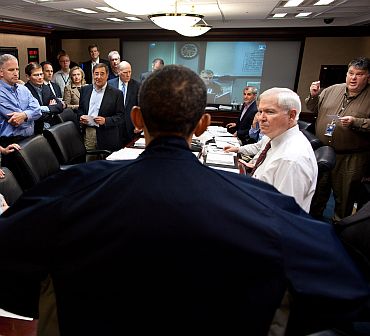
Q: But as you say, how did he resist then, refused to get up off his chair or --
MR. MORRELL: Mik -- (inaudible) -- if the point of this discussion is to try to go into operational details of this mission, it's going to be a very short discussion. So we're just not going to -- we're not going to go into operational details. So if --
Q: But if it was a kill-or-capture mission, why is it that he was killed?
MR. MORRELL: I think he's spoken to this as far as he wants to speak to it. He said he resisted.
MR. MORRELL: Tom Bowman.
Q: Could we get -- into where he was found? He was in this million-dollar mansion a short distance from the Pakistani military facility. What does that tell you about what the Pakistanis knew or didn't know? Do you believe that they were aware he was there or were easily duped? What's your sense of it?
SR. DEFENCE OFFICIAL: (Off mic) -- indications that the Pakistanis were aware that Osama bin Laden was at the Abbottabad compound.
MR. MORRELL: (Briefer name deleted), sorry, we picked you up a little late there. Can you repeat that so we can hear the whole sentence?
SR. DEFENCE OFFICIAL: My apologies. You know, we have no indications that the Pakistanis were aware that Osama bin Laden was at the compound in Abbottabad.
MR. MORRELL: I think he answered the question. There's no indication he was aware.
Q: Can you clarify -- do you know for certain that bin Laden was killed by US bullets, or could he have been killed by his own people? In the past, he's instructed his bodyguards to shoot him if there was a raid to try and capture him. And was an autopsy conducted?
SR. DEFENCE OFFICIAL: I'll defer to our intelligence colleague on the last portion, but he was killed by US bullets.
SR. INTELLIGENCE OFFICIAL: I'm sorry. We didn't hear the last part of the question. My apologies.
MR. MORRELL: Autopsy, (briefer name deleted)?
(Briefer name deleted), the question was, was there an autopsy performed?
SR. INTELLIGENCE OFFICIAL: We're going to have to get back to you on that one. We need to check the facts there.
MR. MORRELL: David Cloud.
Q: Can you give us the justification for burying him at sea? I think I can assume it, but I'd like to hear it from you. And also, will anything be done to this mansion in Pakistan?
SR. DEFENCE OFFICIAL: The justification for burial at sea is when there is no land alternative. And as -- according to Islamic teachings and practice, deceased must be buried with proper procedures within 24 hours. And that was the basis for that decision.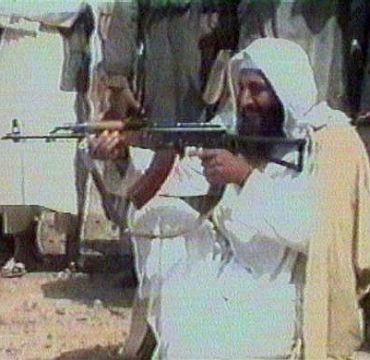
Q: Why was that -- (off mic) -- following exactly? Did you not want him to become -- did you -- obviously, one fear must have been that wherever he was buried would become a place that would attract militants or some other concern.
SR. DEFENCE OFFICIAL: There was no available alternative in terms of a country that was willing to accept the body, and we took pains to ensure that we were compliant with Muslim tradition and law, and sought to dispose of the body, using the appropriate procedures and rituals, within 24 hours.
Q: A question for the senior intelligence officials. We were told last night that, obviously, this operation had been going on for some time, several years, tracking some of these couriers.
Can you talk a little bit more broadly about the hunt over the past 10 years? We have been told over time that the trail had gone cold on bin Laden. Number one, is that true? And can you give us sort of a -- not a blow by blow, but sort of go back to 2001, take us to now and talk through the 10 years, how difficult it was. Was there a point where there was very little intelligence? I think that would be helpful.
SR. INTELLIGENCE OFFICIAL: All right. I think we can walk through that with colleague here very briefly.
The CIA's hunt for Osama bin Laden had been relentless since September 11th, 2001. Prior to our coming across this compound in August of 2010, precise locational information on bin Laden's whereabouts hadn't been known for several years. That being said, we did collect information over time that helped form a picture that, once we came across this compound, enabled us to move swiftly on the intelligence case.
Now, as you know, intelligence cases aren't necessarily built overnight, and it did take time and several months and, you know, vetting of our information to ensure that, you know, we had the highest possible confidence in the information at our disposal. And once the CIA was comfortable -- and, of course, other intelligence agencies and, of course, the president and his national security team were heavily involved in reviewing the intelligence case. And at the end of the day, they made a bold decision to move on a very strong intelligence case that was built up by CIA along with our partners in the intelligence community such as the NSA and NGA.

SR. DEFENCE OFFICIAL: Let me just add -- the president's role in this should not be underestimated. I think there was a body of intelligence that was brought forward to him and his team, as was described, but in the final weeks and really months of this, his personal interest and direction and attention pushed the case to a new level that enabled real action. And I think that role is quite important.
MR. MORRELL: (Briefer name deleted), we have your slides available should you want to speak to them. Just give me your word, and we can pass those out if you want to -- if you want to deal with that.
SR. INTELLIGENCE OFFICIAL: (Off mic) -- hand those out. I'll briefly describe the visuals -- and I don't mean to take much more time. I know we're running low.
But there is a line diagram of the Abbottabad compound, which I think is highly instructive of how much focus there was on operational security. The walls around the compound were up to 18 feet high. The balconies had seven-feet-high privacy walls. There were, in addition to wall heights, barbed wire along the top of the walls. The residents of the compound burned their own trash. There were two gates at the compound, as well, and opaque windows.
So once we came across this compound, we paid close attention to it because it became clear that whoever was living here was trying to maintain a very discreet profile and was practicing a great deal of operational security, and, you know, the compound was designed to obscure lines of sight from multiple directions. That's a very important point.
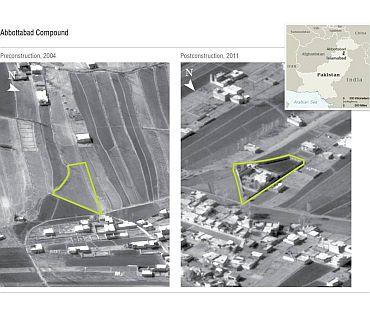
The line diagram, just to lay it out very briefly, shows two main buildings: a three-story building, and then a smaller building toward the bottom of the -- what I'll call the triangle, if you will. And we believe that Osama bin Laden and his family were living on the second and third floors of the main -- the main buildings, and two other families resided in the other building and on the first floor of the bin Laden building. So that's one of the graphics that might be useful.
We also have photos of -- from aerial shots of the Abbottabad compound, and you can see the plot of land that it's built on, and that was in 2004, and then finally post-construction in 2011.
One thing I would note about the compound is that Abbottabad has grown a little bit since 2004, and that this compound, about one acre in size, is, you know, unlike most other residences in the Abbottabad area; much grander scale, valued at approximately $1 million.
The -- you know, Abbottabad is approximately 35 miles northeast -- slightly northeast of Islamabad. And we believe that -- bear with me just a second, a technical issue here -- (pause) -- five years.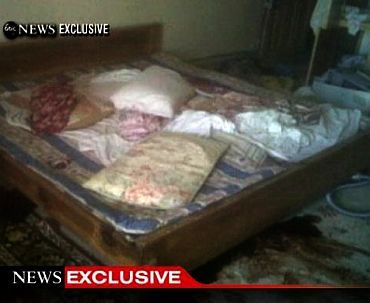
MR MORRELL: Let's go Barbara.
Q: Can your senior intelligence official or yourself -- can you tell the world anything about the last moments alive of Osama bin Laden? Did he die peacefully? Did he die violently? Can you tell us anything about his last moments?
SR. INTELLIGENCE OFFICIAL: He died during a firefight, Barbara.
Q: Did Osama bin Laden actually use a female as a human shield himself? And what does that mean? Was he holding somebody? And also, the family members who survived, were they -- are they being interrogated right now by the Pakistanis? And also, the wife who identified him, did she do so under duress? Is this the youngest wife, as we've heard about? Or did she offer up his name quite readily?
SR. INTELLIGENCE OFFICIAL: I don't know if -- we're not going to get into that kind of detail; that would go to the operational specifics. I don't know if my defence colleagues have a different view.
MR. MORRELL: We concur.

MR. MORRELL: Julian Barnes?
Q: Can you talk a little bit about the coordination with Pakistan? When precisely were they told about this mission? Did this mission, if you can say, launch from Afghanistan or Pakistan? And more broadly, what does this mean for US-Pakistan relations? Is this -- has an irritant been removed? Or is now there going to be more distrust now since he was hiding in a populated area?
SR. DEFENCE OFFICIAL: Since this is a unilateral US operation because of its importance for the nation and our concern about operational security, we did not notify any of our counterterrorism partners in advance.
Once the raid was successfully completed and US personnel were safe, we did immediately call our Pakistani counterparts at multiple levels. I think the White House has told you that the president called President Zardari. Other calls were made to others, including General Kayani. And so we -- those were among the first international calls made to let people know of the operation.
I think -- and to the broader point about cooperation, I think that, you know, since 9/11, in some areas, Pakistan has been quite a steadfast partner in counterterrorism. We appreciate, for example, the positive statement that came from their Foreign Ministry today.
In other areas, that cooperation has not been what we would like it to be, and we continue to have a very candid conversation with the Pakistanis about what more we can and should be doing together to deal with this common challenge.
Q: Was there a worry that Pakistani forces could kind of rush to this compound in the middle of this raid since they obviously didn't know what was going on, and there could be a friendly fire incident?
SR. DEFENCE OFFICIAL: Again, I think our focus was on operational security and ensuring this could be done with success and without interruption.
Q: Can you tell us where the financing came from for this compound and for his being able to keep himself with family and an entourage at this location and whether you recovered any assets such as computers and so forth at the scene?
MR. MORRELL: As our intelligence source, would you care to take those on?
SR. INTELLIGENCE OFFICIAL: Right. The -- on the -- on materials that were collected there, I think we're not going to get into specifics at this point, but it is a robust collection of materials that, you know, we need to -- need to -- need to sift through. And you know, we hope to find valuable intelligence that will lead us to other players in Al-Qaeda.
I'll defer to my colleague on the other questions.
SR. DEFENCE OFFICIAL: Okay. I think our assessment is that given the value of this -- that is, to speak directly to your question, we don't know how this compound was financed, but key to our assessment of its importance and its importance to Al Qaeda was the fact that we assessed that given other intelligence indicating the organization is having financial difficulties, that they would only spend the amount of money to finance this compound and continue to maintain this compound for only probably two of its most senior commanders, that being bin Laden or Zawahiri. And the intelligence led us to conclude it was bin Laden.
SR. INTELLIGENCE OFFICIAL: It's worth bearing mind that, you know, he was more or less hiding in plain sight, in that many of his terrorist associates in other parts of Pakistan and throughout the region are living in much more dire conditions. So you have to be wondering what they're thinking at this moment when they see that their leader was living, relatively speaking, high on the hog, and they're, you know, living in other places that aren't -- that are more remote and not as nice as this city northeast of Islamabad.
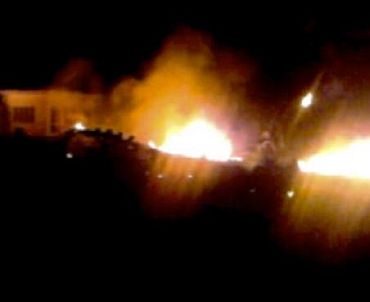
Q: In the training for the mission, did you build a whole, like, fake compound modeled after this in the U.S. for training?
SR. DEFENCE OFFICIAL: I don't want to get into details, but I will say that preparations were extensive. A full range of options -- given the critical importance of the target, a full range of options were considered, and I'll leave it that.
Q: Can I ask you -- can you confirm that it was a [Navy] SEAL team? And was this a specially designated team that had been practicing or reviewing intelligence for a while and they were the unit of choice?
SR. DEFENCE OFFICIAL: Not going to comment on units or numbers. I will say a small US team of special operators and leave it at that.
Chris Lawrence.
Q: I just had a question. Seeing -- looking at the diagram about the walls and things like that, but -- how much did you know about the personnel that were in the compound at the time in terms of manpower, in terms of the weapons they were -- they were in possession of? In other words, did the assault team have a clear idea of exactly what sort of resistance they would face?
And the second question is -- they were in there for 40 minutes. Was Osama bin Laden killed near the beginning of that 40 minutes or was it near the end of that time?
SR. DEFENCE OFFICIAL: I'll answer the latter part of that and then defer to my intelligence colleague. He was killed toward the latter part of that time. (Pause.) Not precisely.
MR. MORRELL: (Briefer name deleted) -- hold on. (Briefer name deleted), did you hear? The question you're deferring is, did -- what resistance did we expect. Is that, (briefer name deleted), what you're deferring?
SR. INTELLIGENCE OFFICIAL: There wasn't perfect visibility on everything inside the compound, but we did have a very, you know, good understanding of the residents who were there, in terms of the number there and in terms of, you know, who, you know, the males were and the women and children. And, you know, over time, we were able to identify a family at the compound that, you know, in terms of numbers, squared with the number of bin Laden family members we thought were probably living with him in Pakistan.
SR. DEFENCE OFFICIAL: The intelligence support was superb. The operators who assaulted the compound felt they had all the intelligence they needed, and they were highly confident in their ability to carry out the mission.

MR. MORRELL: Luis Martinez.
Q: The helicopter that went down, how did that complicate the mission? Did it complicate it significantly? And were you able to get everyone onboard other helicopters in addition to the one you were just talking about?
SR. DEFENSE OFFICIAL: No US personnel were injured; all US personnel successfully extracted. When one does these complex operations, you prepare for a variety of contingencies. The assault force prepared for those, and the operation went as planned.
MR. MORRELL: Missy Ryan.
Q: I'd just like to ask if you can speak to any sort of immediate effect that you would expect for -- on the Afghan insurgency and the campaign across the border in Afghanistan.
And also, just to clarify, when you say -- when we say that it's a -- it was a unilateral US action, does that mean that the reports about Pakistani intelligence or observers being present are false?
SR. DEFENCE OFFICIAL: Let me defer to my intelligence colleague on that.
SR. INTELLIGENCE OFFICIAL: If you can hear me, you know, the intelligence on this compound was shared with no one outside of the US government; and in fact, you know, only a small group of people inside the government were aware.
The Pakistanis, you know, did not know of our interest in the compound, but they did provide us information that helped us develop a clearer focus on this compound over time. So they were not aware of our interest in this compound, but they provided us information attached to it to help us complete the robust intelligence case that, you know, eventually carried the day.
SR. DEFENCE OFFICIAL: As my Department of Defence colleague said, it was a unilateral operation.
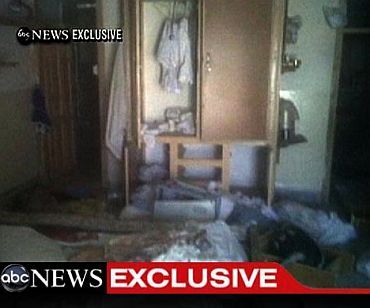
Q: The first part of the question was the impact on the Afghan insurgency, the Afghan campaign.
Q: Who's at fault in the 40-minute -- you said he was killed in the last 40-minute operation. Presumably, he was hiding; you had to root him out. Can you just talk a little bit about how he was found?
SR. DEFENSE OFFICIAL: Well, as my intelligence colleague said, if you look at the line diagram on the last page, there were four military adult males killed on the compound, including Osama bin Laden. Two of those lived in the other compound you see toward the bottom of the picture, and one -- and then on -- in the first floor.
The bin Laden family was on the second and third floor. And so, without getting into operational details, those areas were cleared last.
Q: So presumably there was a lot of ruckus going on. He would just -- obviously, they didn't come out. If you were there for 40 minutes, I would guess you're running through the compound and --
MR. MORRELL: Al.
Q: Yeah, two things. On the burial at sea, was there an imam or a Muslim chaplain present for that? And on the intel piece, what does this say about the value of continuing to interrogate detainees long after they've been captured? Was it that sort of information that led down this road?
SR. DEFENCE OFFICIAL: I'll defer to my intelligence colleague on that last portion. As I indicated in my statement, a military officer read prepared religious remarks, which were translated into Arabic by a native speaker, and all Islamic teachings and procedures -- (inaudible) -- procedures for Islamic burial were followed.
SR. INTELLIGENCE OFFICIAL: (Off mic) -- multiple sources of intelligence, you know, that led us to where we are today with respect to this compound. Key information was gleaned from detainees. And that detainee reporting provided insights into the bin Laden courier network. And so it did -- it did contribute, you know, to the intelligence case. But it was by no means the only bit of information. We had other sources -- I can't describe those -- that helped with the final intelligence picture.
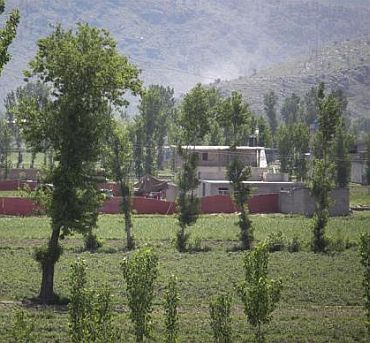
Q: Was the detainee who came up with this nugget of information on the courier network -- had that person been detained for a long time before and interrogated for a long time before that came out?
SR. INTELLIGENCE OFFICIAL: It was multiple detainees debriefed over a number of years, and then it was a composite picture of the courier network and this particular courier that we were interested -- that led us to this compound, that came out of that composite picture and then was developed further through other intelligence means.
Q: Can you talk a little bit about the resistance that the special operators encountered when they -- when they first arrived at the compound? I mean, did bin Laden have guards on duty? I mean, did they -- kind of did the firing begin immediately, or was there some element of surprise involved?
And then I'm also wondering if there will be a reward for the information leading to bin Laden's capture. Are detainees eligible for monetary -- (inaudible)?
SR. DEFENCE OFFICIAL: I will defer to my intelligence colleague on the last part.
On the first part, through most of the 40 minutes during which US special operators were on the compound, they were engaged in a firefight and successive clearing of the -- it was very deliberate. But for most of the period there, there was a firefight.
SR. INTELLIGENCE OFFICIAL: Yeah, I mean, I -- what I would say, you know, to reiterate what my colleague said, is that multiple detainees provided us information and that it's impossible to point to a single person who put us on the trail of Osama bin Laden. You know, I'm not in a position to speak on rewards.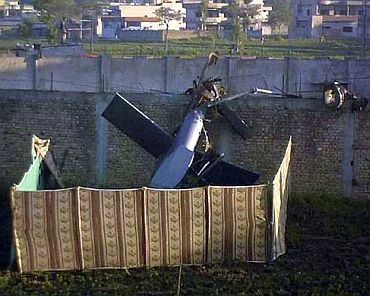
Q: Two questions. One, where was the USS Carl Vinson when the burial took place?
SR. DEFENCE OFFICE: In the North Arabian Sea.
Q: North Arabian Sea. And the other question is, you said a lot of material was taken from the compound. What kind of material was taken?
Q: Justin: Do you plan to release any proof of death, such as images or video of the burial? And why haven't you done that yet?
MR. MORRELL: Yes. This gentleman here.
Q: Who actually performed the rituals, the cleaning of his body? Were they American service members? And why all this for a fellow who most of the world determined was not a very good Muslim anyway? And was in fact a cold blooded killer?
MR. MORRELL: I don't think we care to get into those details.
So Chris -- yeah.
Q: How much do you know about what caused the mechanical problem on that one helicopter? Is that something you would investigate to prevent future mishaps?
SR. DEFENCE OFFICIAL: We -- for these operations, we do extensive hot washes afterwards to look at every aspect of the operation, do what we can improve for next time, and we will certainly look at that. But as I emphasized earlier, the problem that was encountered did not impede the operation in any way.
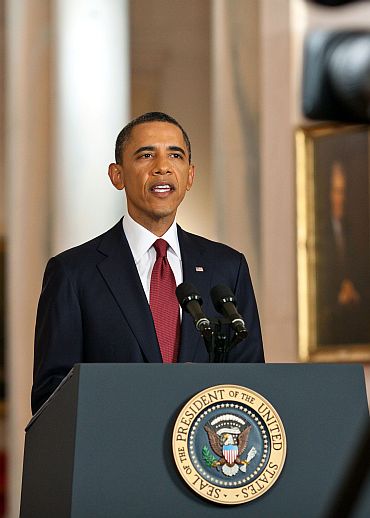
Q: You came to learn about it August 2010. It took you around 10 months to kill him. Was it, doing this, get any risk of repeat of Tora Bora, when he would escape from the hideout?
SR. INTELLIGENCE OFFICIAL: He might depart. Yes, I mean, I think the answer was -- you know, is yes. We were, you know, concerned that -- first of all, we weren't certain in August of 2010 that bin Laden was there. We hadn't developed the complete intelligence picture to that point.
Earlier this year, our confidence level grew much higher. And so, you know, as is the case, you know, with trying to find anyone, you know, you do worry that they may not be there when you arrive. But, you know, we developed good information on how life at the compound, you know, was carried out, and, you know, we were very confident at the end of the day that, you know, we had bin Laden identifiable at this compound and that he would most likely be at the compound when the raid was undertaken.
Q: (Off mic) -- was anyone who was in the compound when the operation began -- did anyone survive the operation? And if so, what happened to them?
SR. DEFENSE OFFICIAL: Oh, yes. There were several women and children on the compound. One woman, who was used as a human shield by one of the four military-age males on the compound, was killed; he was firing behind her. Two women, including one with Osama bin Laden, were wounded. And the rest were not injured at all. The noncombatants were moved to a safe location at the end of the operation, as the damaged helicopter was detonated, to ensure their safety. And I think I've covered it.
Q: But where are they now?
SR. DEFENCE OFFICIAL: They were left -- they were left on the compound.
MR. MORRELL: OK. Thank you. Thank you. Thank you all very much, and I apologize to our intelligence reporters who couldn't chime in via the phone connection, but glad you guys could hear it nonetheless.
Thanks, guys.